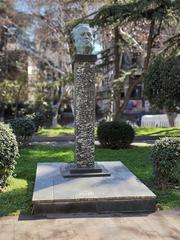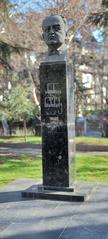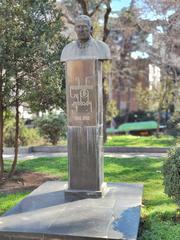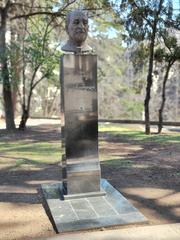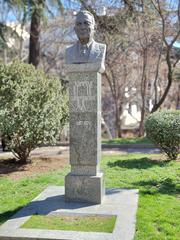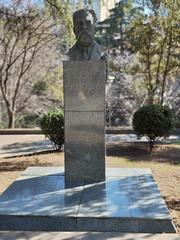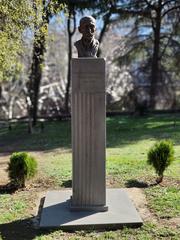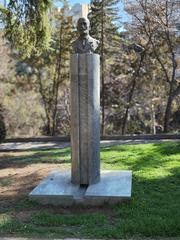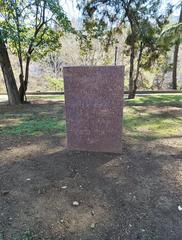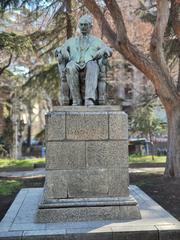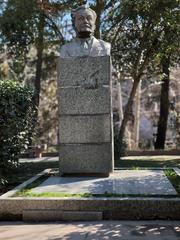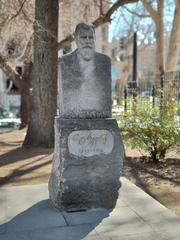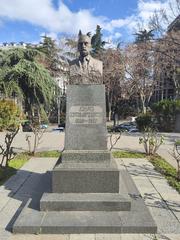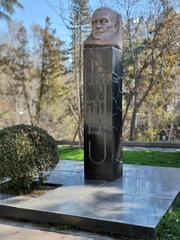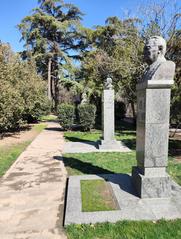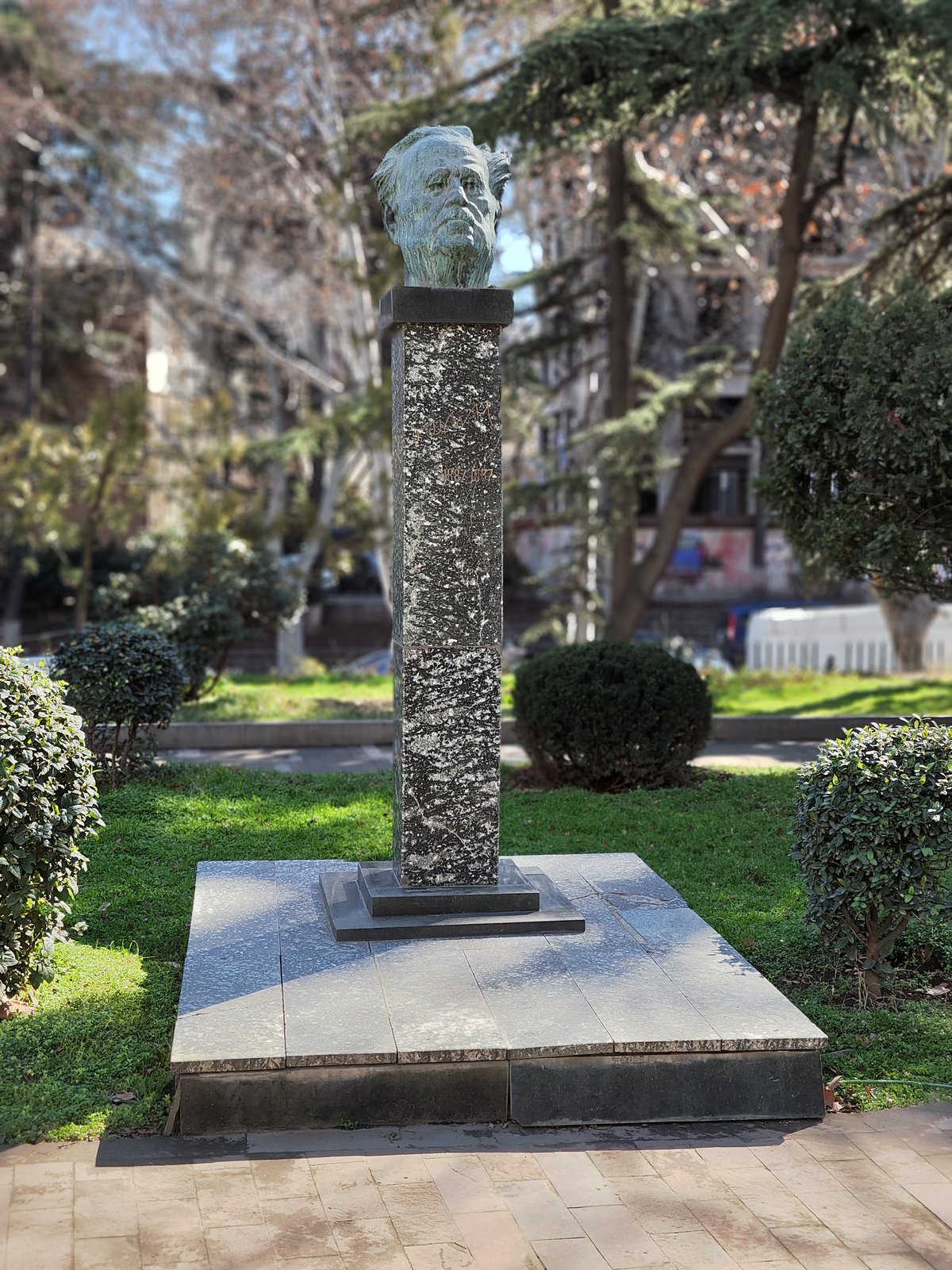
Tbilisi State University Pantheon: Visiting Hours, Tickets, History & Travel Tips
Date: 14/06/2025
Introduction
The Tbilisi State University Pantheon, located within the grounds of Ivane Javakhishvili Tbilisi State University (TSU), stands as a distinguished memorial dedicated to Georgia’s most eminent scholars, scientists, and cultural pioneers. Established in conjunction with the founding of TSU in 1918—the very first modern university in the Caucasus—the Pantheon has become a symbol of national pride, academic achievement, and the enduring Georgian commitment to intellectual freedom.
This guide provides a detailed overview of the Pantheon’s historical and cultural significance, profiles of notable individuals interred there, architectural highlights, practical visitor information (including hours, tickets, accessibility, and guided tours), as well as tips for making the most of your visit to this unique site in Tbilisi.
For further details and the latest visitor updates, consult the Tbilisi State University official website, Wikipedia, and Atinati.
The Pantheon’s Historical and Cultural Significance
Origins and Purpose
The Tbilisi State University Pantheon was established alongside the university’s founding in 1918, during a period of national awakening and the creation of modern Georgian educational institutions. Unlike the more general Mtatsminda Pantheon, which honors literary and public figures, the TSU Pantheon is reserved for the founders, rectors, professors, and scholars who laid the foundations of higher education and academic culture in Georgia (Wikipedia).
The Pantheon reinforces the deep connection between national identity and academic excellence, serving as a place of remembrance and reflection for generations of students, academics, and visitors (Study Georgia, Econstor PDF).
Architectural and Urban Context
Set within the Renaissance Revival-style main building of TSU, the Pantheon is surrounded by elegant white façades, arched windows, and a hemispherical dome—architectural motifs symbolizing enlightenment and universal knowledge (Atinati). The Pantheon’s tranquil garden setting, dotted with sculpted monuments and gravestones, provides a contemplative space that harmonizes with the academic energy of the campus.
Role in National Identity and Public Memory
Being interred in the TSU Pantheon is one of the highest honors in Georgian society, highlighting the inseparable bond between education and national consciousness. The Pantheon is not just a burial site, but a living testament to the values of critical thinking, national service, and scholarly achievement (TSU official site). Academic events and commemorations, including wreath-laying ceremonies, often take place here, reinforcing its ongoing relevance in Georgian public life.
Notable Figures Interred in the Pantheon
Founders and Early Professors
- Ivane Javakhishvili (1876–1940): Historian, linguist, and the principal founder of TSU. His works underpin the study of Georgian history and language. Annual commemorations take place at his grave (TSU official news).
- Petre Melikishvili (1850–1927): The first rector, a chemist who standardized Georgian scientific terminology.
- Shalva Nutsubidze (1888–1969): Philosopher and translator who introduced Western philosophy to Georgia.
- Grigol Tsereteli (1870–1938): Classical philologist who expanded the study of Greek and Roman literature in Georgia.
Eminent Scholars and Scientists
- Nikoloz Muskhelishvili (1891–1976): Mathematician, physicist, and president of the Georgian Academy of Sciences.
- Arnold Chikobava (1898–1985): Linguist noted for his work on Kartvelian languages.
- Simon Janashia (1900–1947): Historian and archaeologist, important in cultural heritage preservation.
Cultural Figures
- Giorgi Akhvlediani (1887–1973): Linguist and pioneer in phonetics.
- Elene Akhvlediani (1898–1975): Painter and graphic artist.
- Niko Berdzenishvili (1894–1965): Historian specializing in the Georgian Orthodox Church.
Each monument is marked by distinctive Georgian sculptural artistry, blending traditional motifs with modernist influences (Study Georgia).
Visiting the Pantheon: Hours, Tickets, Accessibility, and Tips
Visiting Hours
- Monday to Friday: 9:00 AM – 6:00 PM
- Weekends: Hours may vary; check the TSU official site for updates, especially during holidays or academic events.
Tickets and Admission
- Admission: Free of charge; no tickets required.
- Donations: While not mandatory, donations for site upkeep are appreciated.
Accessibility
- Mobility: The Pantheon is wheelchair accessible, with paved paths and ramps.
- Signage: Information is available in Georgian and, at select graves, in English.
Guided Tours
- Availability: Guided tours can be booked through the TSU visitor center or via local tour operators.
- Languages: Tours are primarily in Georgian, with English options available upon request.
Photography and Etiquette
- Photography: Allowed, but visitors should be respectful, especially during ceremonies or commemorations.
- Dress and Behavior: Modest attire and quiet conduct are recommended to honor the solemnity of the site.
Getting There
- Location: Main TSU campus, 1 Ilia Chavchavadze Avenue, Vake district, Tbilisi.
- Transport: Easily reached by public transport, metro (Technical University station), bus, taxi, or on foot from the city center.
Facilities
- Restrooms: Available on campus.
- Cafés/Shops: Numerous options nearby for refreshments.
Nearby Attractions
- Mtatsminda Pantheon: Honors writers and public figures (Wikipedia: Mtatsminda Pantheon).
- Rustaveli Avenue: Tbilisi’s main cultural boulevard.
- Vake Park and Turtle Lake: Relaxing green spaces.
- National Museum of Georgia: For further cultural exploration.
Frequently Asked Questions (FAQ)
Q: What are the Pantheon’s visiting hours?
A: Generally 9:00 AM to 6:00 PM, Monday through Friday. Confirm on the TSU website.
Q: Is there an entrance fee?
A: No, admission is free.
Q: Are guided tours available?
A: Yes, by prior arrangement through the university.
Q: Is the Pantheon wheelchair accessible?
A: Yes, paved paths and ramps ensure accessibility.
Q: Is photography allowed?
A: Yes, but please be discreet and respectful.
Annual Events and Traditions
Each year on February 8 (TSU’s founding day), commemorative ceremonies and wreath-laying take place at the Pantheon, reinforcing its importance in Georgian academic and civic life (TSU official news).
Travel Tips
- Best Time to Visit: Spring and autumn for pleasant weather and fewer crowds.
- Combine Your Visit: Explore the TSU main building or nearby cultural sites for a richer experience.
- Virtual Resources: Check for virtual tours and maps on the TSU official website.
Summary
The Tbilisi State University Pantheon is a vital landmark celebrating the scholars and educators who shaped Georgia’s academic traditions and national identity. With its serene setting, significant monuments, and free public access, it offers a reflective and educational experience for all visitors. Combine your visit with other Tbilisi historical attractions for a comprehensive exploration of the city’s rich cultural heritage.
Sources
- Tbilisi State University, n.d., Official Website (https://www.tsu.ge/en/page/About-University)
- Wikipedia contributors, 2024, Tbilisi State University (https://en.wikipedia.org/wiki/Tbilisi_State_University)
- Atinati, 2022, News Article on TSU Pantheon (https://atinati.com/news/625e8cedb7e78100380cf8d0)
- Geohistory Today, 2023, Tbilisi Historical Sites (https://geohistory.today/tbilisi/)
- Study Georgia, n.d., Ivane Javakhishvili Tbilisi State University (https://study-georgia.ge/ivane-javakhishvili-tbilisi-state-university/)
- Econstor, 2013, National Identity and Education in Georgia (https://www.econstor.eu/dspace/bitstream/10419/54619/1/644229632.pdf)
- Wander-Lush, 2024, Unique Things to Do in Tbilisi (https://wander-lush.org/unique-things-to-do-in-tbilisi-georgia/)
